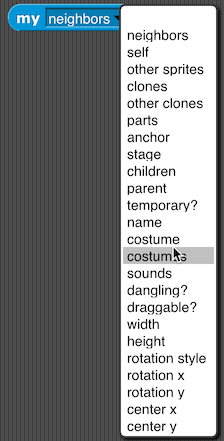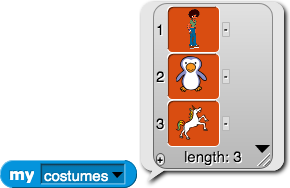Eligiendo un Disfraz
En esta página, tú vas a aprender a programar la funcionalidad para que el usuario pueda elegir el disfraz de su personaje o avatar.
- If it isn't open already, open your U2L1-ClickAlonzo project.
- Add several costumes. Delete the backwards-Alonzo costume. Remove the code in the program that changes the costume when you click the sprite.
- Use
![switch to costume [] switch to costume []](/bjc-r/img/blocks/switch-to-costume.png) to switch the sprite's costume manually a few times.
to switch the sprite's costume manually a few times.
If you're playing your game and you want to change the costume, you can just choose the costume you want by name, in the switch to costume block's pulldown menu. But imagine you're giving this game to a non-programmer friend to play. You want to program the selection of a new costume inside the game, so your friend doesn't have to know anything about blocks.
When you used item of before (for example, inside who and does what) , you were accessing items of the list randomly. But you can also select a specific item by specifying its position.
:
Index
The position number is called the index of the item in the list.

In this list, 1 is the index of the item "apple," 2 is the index of the item "cantaloupe," and so on.
In Snap! and on the AP exam, the index is always a whole number (1, 2, 3, 4, etc.). It is an error to use an index less than 1 or greater than the length of the list.
 Lists can contain anything: letters or words, costumes, other lists, or even blocks. You can use
Lists can contain anything: letters or words, costumes, other lists, or even blocks. You can use my (costumes) to report a list of the costumes for your sprite.

And you can use item of together with my (costumes) to select a costume in a specific position in the list.
Some blocks (such as
item of) have input slots that expect a list. You can tell because the input slot looks kind of like a list:


The list expression

would be written as
costumes[2]
or
![costumes[2] costumes[2]](/bjc-r/img/2-complexity/accessing-blocktran.png)
. All three versions of this code would report/return the penguin costume (if only the AP language had costumes as a data type):

-
 Without using Snap!, predict what each of the following expressions will report:
Without using Snap!, predict what each of the following expressions will report:




- Experiment in Snap! to verify your predictions.
-
Which of the following blocks will report
a list of length 3?
Choose
all that apply.
No, this makes a list of one item, even though it has more than a single word.
No, item 3 of the list is the word "kiwi" which isn't a list at all.
This is one of the two correct answers.
This is one of the two correct answers.
The expression

would be written as
LENGTH(wordsList)
or

.

![switch to costume [] switch to costume []](/bjc-r/img/blocks/switch-to-costume.png) to switch the sprite's costume manually a few times.
to switch the sprite's costume manually a few times.
 Lists can contain anything: letters or words, costumes, other lists, or even blocks. You can use
Lists can contain anything: letters or words, costumes, other lists, or even blocks. You can use 


.png)
![show variable [] show variable []](/bjc-r/img/blocks/show-variable-full-size.png) to show the contents of that variable.
to show the contents of that variable. would be written as
would be written as ![costumes[2] costumes[2]](/bjc-r/img/2-complexity/accessing-blocktran.png) . All three versions of this code would report/return the penguin costume (if only the AP language had costumes as a data type):
. All three versions of this code would report/return the penguin costume (if only the AP language had costumes as a data type):







 would be written as
would be written as  .
.